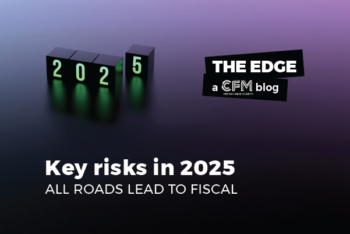Now halfway into the first quarter of 2025 we are starting to see the full roster of performance delivered by the constituents of the SG CTA Index in 2024. Last year saw the index finishing out the year by delivering close to flat performance (+2.4%) despite the good start to the year.
We remain somewhat dismayed by the often-stated opinion that the dispersion of individual CTA performance is currently high or even increasing. We’ve heard chatter that this dispersion was particularly acute in 2024. This bias that a regime shift is always afoot is strong.
First, the SG CTA Index is easily explained by Trend Following strategies (correlation of regression with the index is north of ~85%)1 . Second, inspecting the dispersion between CTAs / Trend Followers, measured as the standard deviation of the monthly returns of SG CTA index constituents (deliberately chosen not to be accused of cherry picking!)2 , is relatively stable and averages at 2% per month3 – see figure 1 below.
We posit that the dispersion chatter in 2024 was likely due to its spike in August, as many CTAs were caught offside by trend reversals, especially the steep equity sell-off during the first week, but also a bounce in the Industrial Metals and Agri complex4. Bar August, the dispersion oscillated neatly around the ~2% long-term average throughout the year.
One can also look at yet another measure of dispersion: the average pairwise correlation between constituents. This measure provides insights into the interaction and co-movement among the returns of the constituent funds (whereas standard deviation provides a sense of the range of performance outcomes). We plot this correlation in figure 2 below, where one finds a similarly stable level at about 50% (and even higher recently)5.
There is, of course, always an eternal stream of news that affect markets. Now feels particularly dizzying – Trump tariffs, heightened tensions in the middle east and Ukraine, the worsening fiscal situation in developed economies to name but a few. But there are also a lot of constants. That CTAs are demonstrably and predominantly Trend Followers is one. Limiting our analysis to the constituents of the SG CTA Index, we do not observe any empirical proof to justify a perception of increased dispersion.
We like and advocate for a core allocation to (well implemented!) Trend Following in institutional portfolios,6 but also advocate for the need to innovate to produce genuinely diversified alpha – defined as something close to zero correlation with traditional benchmarks.
1 Interested readers are encouraged to read our paper ‘Explaining hedge fund index returns’ available for download on our website.
2 The SG CTA Index is reconstituted annually. All the constituent funds for each year since the inception of the index are available from Société Générale. We collected the returns of all constituents from 2010.
3 Stated differently, approximately 2/3 of monthly returns lie within 2% of the SG CTA index return.
4 In early August, hyper-sensitive markets coalesced around the release of a disappointing US jobs report with equity markets correcting. Japanese markets were especially hard hit by the unwinding of leveraged positions and carry trades, the TOPIX closing 10.6% lower on Monday 5 with losses and volatility spreading to other markets.
5 There is a barrage of statistical analysis we threw at measuring dispersion. The results consistently pointed to a stable relationship.
6 In our whitepaper, “A good time for Trend Following … but, then again, it’s always been!” we empirically espouse the many (and consistent) merits of trend following as a core allocation in institutional portfolios. The whitepaper is available for download on our website.
DISCLAIMER
Any statements regarding market events, future events or other similar statements constitute only subjective views, are based upon expectations or beliefs, involve inherent risks and uncertainties and should therefore not be relied on. Future evidence and actual results could differ materially from those set forth, contemplated by or underlying these statements. In light of these risks and uncertainties, there can be no assurance that these statements are or will prove to be accurate or complete in any way. All opinions and estimates included in this document constitute judgments of CFM as at the date of this document and are subject to change without notice. CFM accepts no liability for any inaccurate, incomplete or omitted information of any kind or any losses caused by using this information. CFM does not give any representation or warranty as to the reliability or accuracy of the information contained in this document. The information provided in this document is general information only and does not constitute investment or other advice. The content of this document does not constitute an offer or solicitation to subscribe for any security or interest.





